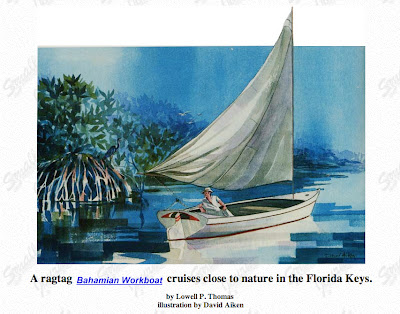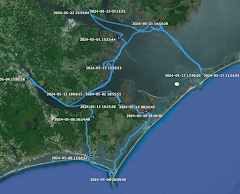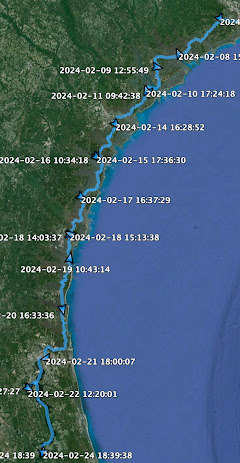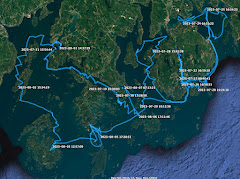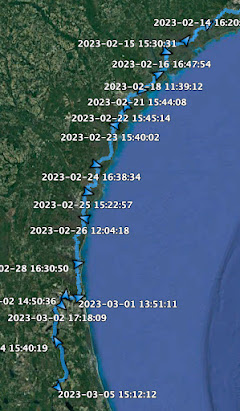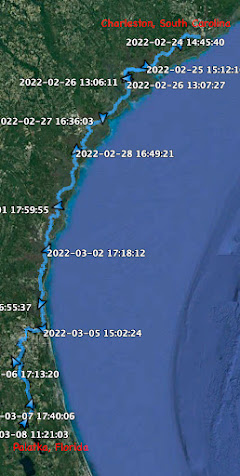Morning comes cool and clear on Allison Creek. The rain that fell last night is gone, the boat is dry save for underneath the bivy. I pack away the sleeping gear but instead of putting the bivy in the stuff sac I roll it up loosely and tuck it under the bungee cords under the foredeck. I will have time to hang it out to dry in Belhaven.
We leave the creek before 6:30, the sun peeking through the pines to the east. I think about breakfast in town - eggs over easy, bacon, toasted whole wheat and a nice glass of iced tea - as Spartina returns to the Pungo River. The wind is light and faltering. I realize it is lunch, not breakfast, that is in my future. I hear a gurgling noise that is not justified by Spartina's slow speed. I look over the side and see that I'm dragging the rope boarding anchor that I put out for my swim yesterday evening.
A west wind fills in at 7:30. I look north and see a sail coming around Durants Point. Then a second sail, soon three and then five. Maybe it is local boats out for a regatta, or maybe a club sail to Pamlico Sound. Power boats, their owners casting lures, drift off the marsh at the mouth of Fishing Creek.
At 9 a.m. we pass the "1BC" marker and begin a series of tacks, pleasant relaxed tacks, up the channel to Belhaven. I see something I missed on my chart. There is a wooden breakwater that reaches across the mouth of Pantego Creek with an opening in the center. Just after 10:00 a.m. Spartina passes through the entrance and we are in the creek off of the River Forest Marina. It looks to be a nice facility, but it also looks to be several blocks from downtown.
Instead of having to make that walk to Belhaven, I sail up the wide creek in search of a dock closer to downtown. I turn into a marina that is filled mostly larger boats and has no transient dock. A man on the pier points me towards a new public dock a hundred yards to the west. The dock is so new that lumber tags are still stapled to the ends of the boards and a muddy field is waiting for sod. But it is well built, safe and - most importantly - free. I tie up, hang the bivy over the boom to dry and head into town.
A quick walking tour of downtown Belhaven reveals a nice clean 1950's era waterfront town three blocks long and two blocks wide. Beautiful brick buildings, mostly empty with "for rent" or "for sale", line the streets. A couple of restaurants, a drugstore, and two cell phone shops. The police station is a double wide trailer and I wonder why they don't use one of the empty buildings instead.
Of the two restaurants, I choose the one where I can sit inside and enjoy the air conditioning - Fish Hooks Cafe. The waitress apologizes for the simple saturday lunch menu, she tells me the time to be there is on week nights or for Sunday brunch. But a salad bar and iced tea is just fine for me. Photographs on the wall from decades ago show a bustling waterfront town.
It is hot and windless as we motor away from the dock. I look at the flags on top of buildings in Belhaven, not even a hint of a breeze. We pass through the breakwater under power and motor south on glassy calm water. All sails are up but the only benefit is a patch of shade from the main on the port side where I sit and dunk my hat in the river water. I keep my feet in the shade of the seats, the decks are too hot to touch. I almost never where sunglasses, but the reflection of the sun on the smooth water is harsh. I dig around in my day storage box until I find an old pair of clip-ons.
The jib sheets dance now and then on the foredeck, the wind teases. I see clouds building on the far side of the Pamlico River. Weather radio tells me there is a line of severe thunderstorms twenty miles to the south and I am glad I'm not on West Bay where I had anchored two nights before. The clouds continue to build and seem to be getting closer. Weather radio says nothing about them.
I see boats with sails full near the mouth of the Pungo River. Wind out of the southwest. Finally. Then the wind swings to the northwest. And then back southwest, but this time it is the cool outflow winds coming from under the thunderstorms. Off of Currituck Point the wind picks up as the skies darken. I want to get out around Willow Point into Spencer Bay but the point is three miles away and after baking in the hot sun with no wind all afternoon I find I have too much sail up.
I think about pointing up and tucking in a reef, then I think again about finding protection. I drop the main and under mizzen and jib head north into Abel Bay. We duck into Berry Creek but find it too narrow, not enough room to put out the anchor line and swing 360 degrees - something which often happens in thunderstorms. I sail back out and into the mouth of Bell Creek. It is more exposed to the southwest than I like, but plenty of room to let out a lot of anchor line.
I eat a quick dinner wearing my foul weather gear. No rain yet, just swirling clouds.
With cooking gear stowed I see a wall of wind and rain coming our way. I use the hand pump to get the water off the bunks flats up forward, a cup to scoop the water from the sole of the aft cockpit. The water builds up in the cockpit faster than I expect. My back feels wet and I wonder if my foul weather jacket is delaminating, or maybe it is sweat.
The rain ends, the wind calms and I relax. At least the boat is clean. Then I see swirling clouds to the north, accompanied by lighting. Then more rain. I bail and wonder why I did not bother to put the boom tent up.
There is more lighting than I like. I take a break, sit up forward and watch the rain fall. I think about curling up under the foredeck, but choose to stay where I am. And I think sailing, good weather and bad weather. And I think about the deal I make with myself when I go on a small boat for a few days.
The second cell moves through, I dry out the boat and this time get the boom tent set. The third storm cell arrives. Less rain, less lightning, more wind. The cell moves through and the skies clear, but the wind stays and Spartina rocks in the steep chop from side to side. I fall asleep in the bivy.
I wake in the darkness of the boom tent to the sound of blaring mariachi music. Confused, I think it is from a crabber's boat. But in the middle of the night? Then I realize it is my am/fm radio. I climb out of the bivy, go to the back of the boat and push the power button but the music continues. None of the buttons work. The rain, traveling horizontally in the storms, must have gotten in the radio and shorted out the circuits. At least the volume knob works. I turn down the volume so I can no longer hear the music and go back to bed.
steve








